A Brilliant Conductor
NIH Hosts Ceremonial Portrait Debut for Collins
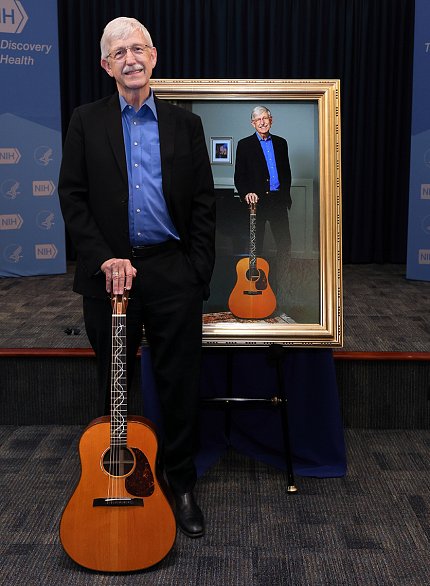
Photo: Chia-Chi Charlie Chang
It was an afternoon of celebration, reflection and, not too surprisingly, a little music.
Colleagues, family and friends of former NIH Director Dr. Francis Collins convened in Bldg. 1’s Wilson Hall in June for his official portrait debut. The event’s distinguished speakers referred to Collins—the 16th and longest-serving presidentially appointed NIH director (2009-2021)—as a brilliant and devoted scientist, a visionary and a man of integrity, compassion and faith.
“As NIH director, Francis was always the champion of hope, of rare diseases, of big ideas and big projects to transform what biomedical research is capable of,” said NIH Director Dr. Monica Bertagnolli. “He made us believe that the big things were not only important, they were also possible.”
Andrea Palm, deputy secretary of the Department of Health and Human Services, concurred. “We’re all lucky to have had him telling our story, the story of NIH, for all these years,” she said. “It’s really not an overstatement to say that Dr. Collins has, [through major initiatives] and in his own lab, saved countless lives and inspired generations of doctors and scientists.”
Artistry
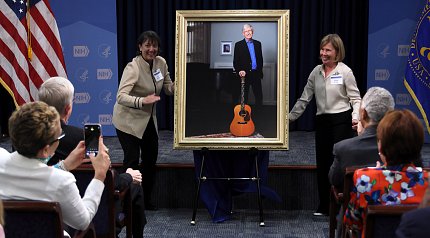
Photo: Chia-Chi Charlie Chang
The centerpiece sat covered up front. Bertagnolli and Collins’s wife, Diane Baker, pulled back the drape to reveal a befitting portrait of Collins standing, smiling, leaning on his guitar—with its signature DNA fretboard design—that has made frequent appearances throughout his time at NIH. The picture even captures Collins’s optimism, the rays of hope, with sunlight beaming in through the window.
Previous NIH director portraits have been paintings. Collins becomes the first to be represented with a photograph. The photographer, Visko Hatfield, has snapped high-profile images before at NIH and, incidentally, is the son of the late Sen. Mark Hatfield, namesake of NIH’s Clinical Research Center.
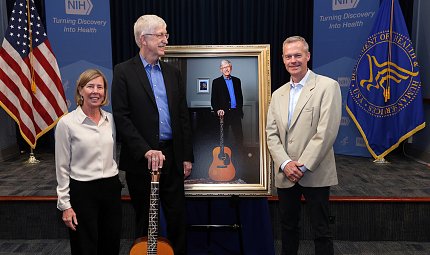
Photo: Chia-Chi Charlie Chang
“We applaud the artistry of Visko Hatfield for capturing a multidimensional force of nature—Francis Collins—in a two-dimensional space,” said NIH Principal Deputy Director Dr. Lawrence Tabak. “And we honor the multidimensional man himself—the leader, the scientist, the administrator, the musician.”
From his front-row seat during those years, Tabak lauded Collins for his many successes and how he deftly navigated difficult, unforeseen circumstances such as the Covid-19 pandemic.
“Very few people really know the extraordinary passion and energy Francis had during that historic period,” Tabak said. “Francis personifies boundless compassion for humans.…He demonstrates a laser focus each and every day.”
Progress
Former U.S. Sen. Roy Blunt (R-MO) credited Collins for the sweeping changes in health care over the past 20 years.
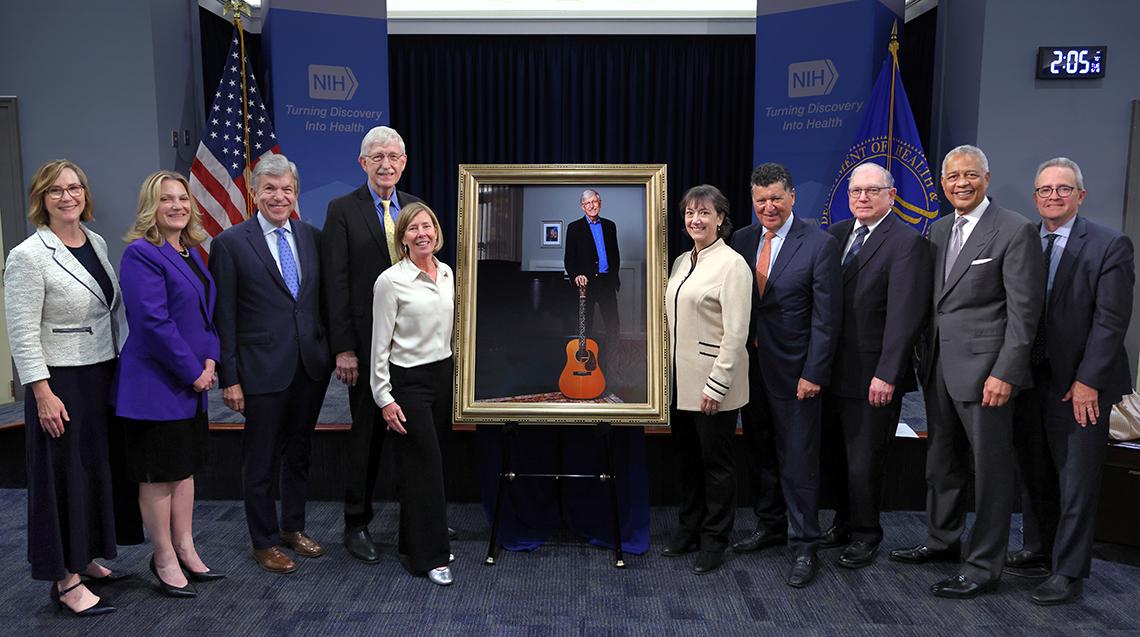
Photo: Chia-Chi Charlie Chang
Upon completing the Human Genome Project, which Collins led while director of the National Human Genome Research Institute (NHGRI), “we began to talk about health care in a different way,” Blunt said, from personalized medicine to CRISPR gene editing to immunotherapy. He also praised Collins for his ability to find common ground while working under three very different U.S. presidents.
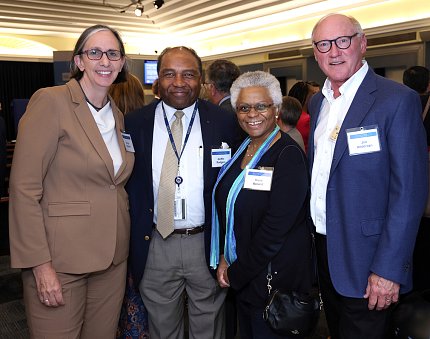
Photo: Chia-Chi Charlie Chang
“It was not by accident that different administrations and the scientific community kept on asking for more of you,” said Dr. Anthony Fauci, former director of the National Institute of Allergy and Infectious Diseases, via pre-recorded message. “We all recognized your incredible instinctive ability to cultivate relationships with members of Congress on both sides of the aisle, and with administrations of both parties, as well as your amazing ability to communicate science at multiple levels.”
Fauci recalled the agency-wide excitement when Collins was first recruited from the University of Michigan to lead NHGRI, where he has since returned as a senior investigator. Fauci highlighted Collins’s groundbreaking work on cystic fibrosis through his current research on progeria and type-2 diabetes. He also recounted speaking or meeting with Collins almost daily during the pandemic.
“Your personal integrity, your true commitment to equity at every level in science and government and your passion to serve the underserved are some of the many reasons why I have such high respect for you, and value our friendship so much.”
Explorer
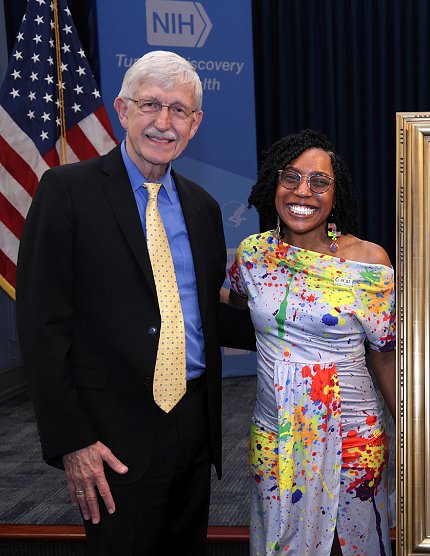
Photo: Chia-Chi Charlie Chang
Dr. Elias Zerhouni, who preceded Collins as director, said, “He has a characteristic that very few scientists, visionary or not, have: He is fundamentally at heart an explorer.”
It’s a painstaking and arduous process searching to discover a disease gene. Then came the human genome, making Collins a world-class explorer, Zerhouni noted.
Dr. Reed Tuckson, co-founder of the Black Coalition Against Covid and longtime NIH advisor, also described Collins as having “an unquenchable drive for discovery.”
“I will never forget the earnestness and seriousness of his call to me, requesting I help him to address the frustrating lack of equity in NIH grants that he believed limited the fullest expression of scientific discovery,” Tuckson said. “I continue to be inspired by Francis’s genuinely humble and self-effacing leadership style that was so consistently successful in bringing scientists and clinicians from diverse disciplines together.”
And, Collins has always peered outward, exploring how he could help others.
“Thank you for continuing to worry about the potential of the next generation of NIH scientists,” Zerhouni said.
Discovery
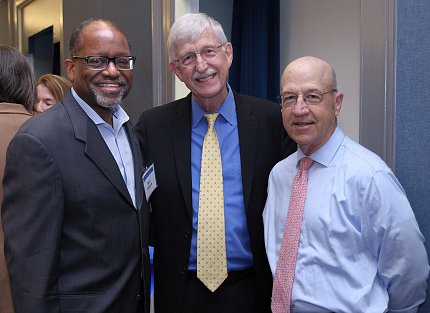
Photo: Chia-Chi Charlie Chang
Baker, a pioneer in the field of genetic counseling, shared personal stories of how her husband rises to the occasion when bad news hits.
“‘We’ve got to fix this’ is something I’ve heard a lot,” she said. “He wants to hear every gory detail and then he wants to get things back on track.”
A performer since childhood in Staunton, Va., Collins “appreciates all the stages he’s been on,” Baker said, “but his passion is with people and progress. He moves forward embracing the problems, looking for solutions, loving the big ideas and looking forward to how he’s going to implement them.”
Among the big ideas Collins set in motion during his tenure as director include the BRAIN initiative, exploring how the brain works; All of Us, a massive precision medicine effort; HEAL, to address the opioid epidemic; and UNITE, to reduce structural racism and health disparities across biomedical research. In another proud feat, he helped recruit many institute/center directors and, among them, increased the number of women.
In his remarks, Collins took a moment to reflect on the somber state of affairs today that makes vigilance and advocacy all the more urgent. Society is polarized, he said. Distrust in science is growing.
“But in the midst of this storm, we’re going to hold our heads high that we are devoted to a noble enterprise,” Collins said. “More than ever, I think we have to be prepared at all times, for all audiences and in all places, to tell the stories of how our work carries the best hope for revealing answers to ancient mysteries and providing healing for the many heartbreaks of the world’s people.”
Chorus

Photo: Chia-Chi Charlie Chang
Then, Collins reached behind the curtain to reveal the other subject of his official portrait, his guitar, Rosalind, named after Dr. Rosalind Franklin, a British chemist whose research in the 1950s was integral to understanding molecular DNA.
Collins had written new lyrics to the folk song, “All the Good People,” and soon had his audience singing along to the chorus.
“With this portrait,” Palm said, “there will be a constant reminder of what is possible, the hope [Collins] brought out in all of us and what we can achieve. He’ll inspire us and the next generation of scientists just by hanging around.”
